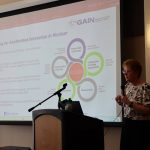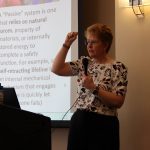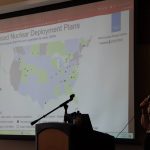Price City Mayor Mike Kourianos kicked off the Gain Insight Into Nuclear Power presentation that was hosted at USU Eastern on Tuesday afternoon. This public forum was held in order to explore the integration of nuclear power in Utah’s energy mix alongside existing energy sources.
Community members, commissioners, city council members, Carbon County Chamber of Commerce members and much more were in attendance to be part of this important conversation.
Mayor Kourianos stated that there are a number of local leaders that have been coming together to see what the future holds and, with a lot of things that are at stakes, there are a lot of people that are nervous about it.
Gateway for Accelerated Innovation in Nuclear (GAIN) is working to help the community with a wealth of knowledge and experience in nuclear energy.
Christine King, who is the Director of GAIN, led the presentation and stated that their goal is to ensure that the assets of the national labs and Department of Energy are used and useful in the pursuit of nuclear technology.
King wished to give information in order for nuclear technology not to be intimidating and she wished for everyone to participate in the conversation. King also said that social license with building these technologies is important and, at GAIN, they try to be the first place for stakeholders that are interested in nuclear.
King’s job is to act as the single point of contact and give answers needed without having to navigate what may, at times, be too complex.
From there, King went in depth in regard to advanced nuclear reactor concepts, such as molten salt, liquid metal and gas-cooled, which are the different categories that are under development. The benefit of these coolants is that they are more dense fluids and allows to operate at lower pressures and higher temperatures.
In terms of Advanced Nuclear Versatility, there is a spectrum of sizes and options, such as micro, mini and small. There is also a variety of outputs, such as electricity, hydrogen and process heat.
Nuclear technology features a multitude of end uses, ranging from homes, vehicles and businesses to aviation, rail, steel, concrete and more.
Normally, when the temperature is raised the pressure goes up. However, with a denser fluid, they are able to operate at a lower pressure. King then explained that a uranium pellet, which is about the size of a gummy bear, has energy equivalent to a ton of coal, 120 gallons of oil or 17,000 cubic feet of natural gas.
King also went over safety systems such as an active passive system and human interventions in shutting down a reactor. She explained that on a plant site, there is a nuclear island and an energy island. When a nuclear plant is sited, there are about 30 factors to look at, with some things being changeable and some not.
King informed those in attendance that permitting and construction can be started before the particularly technology for the plant is chosen.
Following the decision of the technology, construction can begin, as well as the licensing process. It would take almost 10 years from the planning phase to the licensing phase and finally, the construction phase. Early site permits are viable for 20 years.
The floor was then opened for a question and answer portion, in which many questions were voiced to King, who worked diligently to keep the community informed on nuclear power.







